 W
W1st Issue Special was a comics anthology series from DC Comics, done in a similar style to their Showcase series. It was published from April 1975 to April 1976. The goal was to showcase a new possible first issue of an ongoing series each month, with some issues debuting new characters and others reviving dormant series from DC's past. No series were actually launched from 1st Issue Special but the Warlord made his first appearance in the title and the character's ongoing series was already slated to debut a few months later.
 W
WAdventure into Fear is an American horror comic book series published by Marvel Comics from cover dates November 1970 through December 1975, for 31 issues. This is its trademarked cover title for all but its first nine issues, though the series is copyrighted in its postal indicia as simply Fear.
 W
WAll Star Comics is an American comic book series from All-American Publications, one of three companies that merged with National Periodical Publications to form the modern-day DC Comics. While the series' cover-logo trademark reads All Star Comics, its copyrighted title as indicated by postal indicia is All-Star Comics, with a hyphen. With the exception of the first two issues, All Star Comics told stories about the adventures of the Justice Society of America, the first team of superheroes, and introduced Wonder Woman.
 W
WThe All-Star Squadron is a DC Comics superhero team that debuted in Justice League of America #193 and was created by Roy Thomas, Rich Buckler and Jerry Ordway.
 W
WThe Amazing Spider-Man is an American comic book series published by Marvel Comics, featuring the fictional superhero Spider-Man as its main protagonist. Being in the mainstream continuity of the franchise, it began publication in 1963 as a monthly periodical and was published continuously, with a brief interruption in 1995, until its relaunch with a new numbering order in 1999. In 2003 the series reverted to the numbering order of the first volume. The title has occasionally been published biweekly, and was published three times a month from 2008 to 2010.
 W
WThe Amazing World of DC Comics was DC Comics' self-produced fan magazine of the mid-1970s. Running 17 issues, the fanzine featured DC characters and their creators, and was exclusively available through mail order. Primarily text articles, with occasional strips and comics features, Amazing World offered a great deal of insight into Bronze Age DC corporate and creative culture.
 W
WAstonishing Tales is an American anthology comic book series originally published by Marvel Comics from 1970-1976. Its sister publication was Amazing Adventures vol. 2.
 W
W"Atlantis Attacks" was a comic book superhero crossover storyline which ran through most of the summer annuals published by Marvel Comics in 1989.
 W
WThe Avengers is the name of several comic book titles featuring the team the Avengers and published by Marvel Comics, beginning with the original The Avengers comic book series which debuted in 1963.
 W
WBatman Family is an American comic book anthology series published by DC Comics which ran from 1975 to 1978, primarily featuring stories starring supporting characters to the superhero Batman. An eight-issue miniseries called Batman: Family was published from December 2002 to February 2003.
 W
WThe Brave and the Bold is a comic book series published by DC Comics as an ongoing series from 1955 to 1983. It was followed by two mini-series in 1991 and 1999, and was revived as an ongoing title in 2007. The focus of the series has varied over time, but it most commonly features team-ups of characters from across the DC Universe.
 W
WCaptain America is the name of several comic book titles featuring the character Captain America and published by Marvel Comics, beginning with the original Captain America comic book series which debuted in 1968.
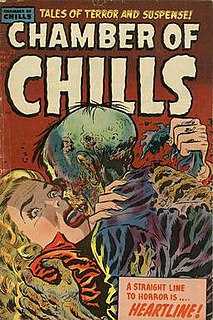 W
WChamber of Chills is the name of two anthology horror comic books, one published by Harvey Publications in the early 1950s, the other by Marvel Comics in the 1970s.
 W
WChamber of Darkness is a horror/fantasy anthology comic book published by the American company Marvel Comics. Under this and a subsequent name, it ran from 1969 to 1974. It featured work by creators such as writer-editor Stan Lee, writers Gerry Conway, Archie Goodwin, and Roy Thomas, and artists John Buscema, Johnny Craig, Jack Kirby, Tom Sutton, Barry Windsor-Smith, and Bernie Wrightson. Stories were generally hosted by either of the characters Digger, a gravedigger, or Headstone P. Gravely, in undertaker garb, or by one of the artists or writers.
 W
WCreepy was an American horror-comics magazine launched by Warren Publishing in 1964. Like Mad, it was a black-and-white newsstand publication in a magazine format and did not carry the seal of the Comics Code Authority. An anthology magazine, it initially was published quarterly but later went bimonthly. Each issue's stories were introduced by the host character, Uncle Creepy. Its sister publications were Eerie and Vampirella.
 W
WDaredevil is the name of several comic book titles featuring the character Daredevil and published by Marvel Comics, beginning with the original Daredevil comic book series which debuted in 1964.
 W
WDC Challenge was a 12-issue comic book limited series produced by DC Comics from November 1985 to October 1986, as a round robin experiment in narrative. The series' tagline was "Can You Solve It Before We Do?"
 W
WDC Comics insert previews were 16-page comic book stories inserted into issues of existing DC Comics series to promote new series usually debuting the next month. Running from 1980 to 1985, they consisted of a front cover, 14 pages of story, and a back cover that depicted the cover of the actual first issue. The addition of the insert did not entail an increase in the price of the comic book, and the cover copy called the insert "a special free 16-page comic!"
 W
WDC Comics Presents is a comic book series published by DC Comics from 1978 to 1986 which ran for 97 issues and four Annuals. It featured team-ups between Superman and a wide variety of other characters in the DC Universe. A recurring back-up feature "Whatever Happened to...?" had stories revealing the status of various minor and little-used characters.
 W
WDC Retroactive is a line of one-shot comic book titles published by DC Comics. It revisited periods of the company's main characters: Batman, Superman, Wonder Woman, Green Lantern, the Justice League, and the Flash. These comics were published with cover dates of September and October 2011. The DC Retroactive comic books followed the Flashpoint events and were launched just before The New 52 line wherein DC titles were relaunched starting from #1.
 W
WDC Special was a comic book anthology series published by DC Comics originally from 1968 to 1971; it resumed publication from 1975 to 1977. For the most part, DC Special was a theme-based reprint title, mostly focusing on stories from DC's Golden Age; at the end of its run it published a few original stories.
 W
WDC Special Series was an umbrella title for one-shots and special issues published by DC Comics between 1977 and 1981. Each issue featured a different character and was often in a different format than the issue before it. DC Special Series was published in four different formats: Dollar Comics, 48 page giants, digests, and treasury editions. Neither the umbrella title nor the numbering system appear on the cover; the title "DC Special Series" appeared only on the first page in the indicia. Most issues featured new material, but eight issues were reprints of previously published material.
 W
WDC Super Stars was a comics anthology series published by DC Comics from March 1976 to February 1978. Starting off as a reprint title, it finished its run with original stories.
 W
WThe Deadly Hands of Kung Fu was an American black-and-white martial arts comics magazine published by Magazine Management, a corporate sibling of Marvel Comics. A total of 33 issues were published from 1974 to 1977, plus one special edition. Additionally, a color Marvel comic titled simply Deadly Hands of Kung Fu was published as a 2014 miniseries.
 W
WThe Defenders are a set of fictional superhero groups with rotating membership appearing in American comic books published by Marvel Comics. They are usually presented as a "non-team" of individualistic "outsiders" who, in their prior adventures, are known for following their own agendas. The team often battle mystic and supernatural threats.
 W
WDracula Lives! was an American black-and-white horror comics magazine published by Magazine Management, a corporate sibling of Marvel Comics. The series ran 13 issues and one Annual from 1973 to 1975, and starred the Marvel version of the literary vampire Dracula.
 W
WEerie was an American magazine of horror comics introduced in 1966 by Warren Publishing. Like Mad, it was a black-and-white magazine intended for newsstand distribution and did not submit its stories to the comic book industry's voluntary Comics Code Authority. Each issue's stories were introduced by the host character, Cousin Eerie. Its sister publications were Creepy and Vampirella.
 W
W"The Evolutionary War" was a comic book crossover which ran through most of the 1988 annuals published by Marvel Comics. Principal writers included Gerry Conway, Steve Englehart, Louise Simonson, Chris Claremont, and Steve Gerber.
 W
WFantastic Four is the name of several comic book titles featuring the team Fantastic Four and published by Marvel Comics, beginning with the original Fantastic Four comic book series which debuted in 1961.
 W
WHeroes Against Hunger is a 1986 all-star benefit comic book for African famine relief and recovery. Published by DC Comics in the form of a "comic jam," or exquisite corpse, the book starred Superman and Batman. Spearheaded by Jim Starlin and Bernie Wrightson, all proceeds from the comic went to hunger relief in Africa.
 W
WThe House of Mystery is the name of several horror, fantasy, and mystery Comics anthologies published by DC Comics. It had a companion series, House of Secrets. It is also the name of the titular setting of the series.
 W
WThe Incredible Hulk is an ongoing comic book series featuring the Marvel Comics superhero the Hulk and his alter ego Dr. Bruce Banner. First published in May 1962, the series ran for six issues before it was cancelled in March 1963, and the Hulk character began appearing in Tales to Astonish. With issue #102, Tales to Astonish was renamed to The Incredible Hulk in April 1968, becoming its second volume. The series continued to run until issue #474 in March 1999 when it was replaced with the series Hulk which ran until February 2000 and was retitled to The Incredible Hulk's third volume, running until March 2007 when it became The Incredible Hercules with a new title character. The Incredible Hulk returned in September 2009 beginning at issue #600, which became The Incredible Hulks in November 2010 and focused on the Hulk and the modern incarnation of his expanded family. The series returned to The Incredible Hulk in December 2011 and ran until January 2013, when it was replaced with The Indestructible Hulk as part of Marvel's Marvel NOW! relaunch.
 W
WIron Man is the name of several comic book titles featuring the character Iron Man and published by Marvel Comics, beginning with the original Iron Man series that debuted in 1968.
 W
WLimited Collectors' Edition is an American comic book series published by DC Comics from 1972 to 1978. It usually featured reprints of previously published stories but a few issues contained new material. The series was published in an oversized 10" x 14" tabloid format.
 W
WMarvel Graphic Novel (MGN) is a line of graphic novel trade paperbacks published from 1982 to 1993 by Marvel Comics. The books were published in an oversized format, 8.5" x 11", similar to French albums. In response, DC Comics established a competitor line known as DC Graphic Novel.
 W
WMarvel Spotlight is a comic book anthology series published by Marvel Comics as a try-out book. It stood out from Marvel's other try-out books in that most of the featured characters made their first appearance in the series. The series originally ran for 33 issues from November 1971 to April 1977. A second volume ran for 11 issues from July 1979 to March 1981.
 W
WMarvel Team-Up is an American comic book series published by Marvel Comics. The series featured two or more Marvel characters in one story. The series was originally published from March 1972 through February 1985, and featured Spider-Man as the lead "team-up" character in all but ten of its 150 issues, and in six of its seven Annuals. It was the first major ongoing spin-off series for Spider-Man, being preceded only by the short-lived The Spectacular Spider-Man magazine. Of the issues that did not star Spider-Man, the Human Torch headlines six issues ; the Hulk, four ; and Aunt May, one (#137). Publication of most of the issues starring the Human Torch coincided with that of Giant-Size Spider-Man, an alternate Spider-Man "team-up"-themed series by the regular Marvel Team-Up creative team. When cancelled with #150 in 1985, the title was replaced by Web of Spider-Man.
 W
W"The Night Gwen Stacy Died" is a story arc of the Marvel Comics comic book series The Amazing Spider-Man #121–122, that became a watershed event in the life of the superhero Spider-Man, one of popular culture's most enduring and recognizable fictional characters. The two-issue story, written by Gerry Conway, with pencil art by Gil Kane and inking by John Romita Sr. and Tony Mortellaro, features Spider-Man's fight against his nemesis, the Green Goblin. The Green Goblin abducts Spider-Man's girlfriend Gwen Stacy, and she is killed during the battle.
 W
WThe Phantom Stranger is a fictional superhero of unspecified paranormal origins, who battles mysterious and occult forces in various titles published by DC Comics, sometimes under their Vertigo imprint. The character first appeared in an eponymous comics anthology published in August/September 1952.
 W
WThe Savage Sword of Conan was a black-and-white magazine-format comic book series published beginning in 1974 by Curtis Magazines, an imprint of American company Marvel Comics, and then later by Marvel itself. Savage Sword of Conan starred Robert E. Howard's most famous creation, Conan the Barbarian, and has the distinction of being the longest-surviving title of the short-lived Curtis imprint.
 W
WSavage Tales is the title of three American comics series. Two were black-and-white comics-magazine anthologies published by Marvel Comics, and the other a color comic book anthology published by Dynamite Entertainment.
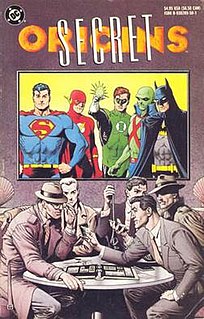 W
WSecret Origins is the title of several comic book series published by DC Comics which featured the origin stories of the publisher's various characters.
 W
WSgt. Fury and his Howling Commandos was a comic book series created by Jack Kirby and Stan Lee and published by Marvel Comics from 1963 to 1981. The main character, Sgt. Nick Fury, later became the leader of Marvel's super-spy agency, S.H.I.E.L.D. The title also featured the Howling Commandos, a fictional World War II unit that first appeared in Sgt. Fury and his Howling Commandos #1.
 W
WSpitfire and the Troubleshooters was a short-lived comic book series from Marvel Comics' New Universe line. It followed "Spitfire" and a group of brilliant but eccentric college students as they used high-tech powered exoskeletons to combat the mysterious terrorist organization called The Club.
 W
WSuper-Team Family is a comic book anthology series published by DC Comics from 1975 to 1978 that lasted for 15 issues. It included a mix of original and reprinted stories.
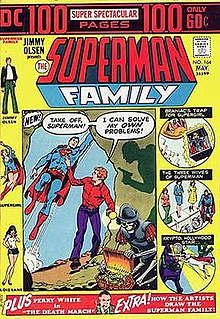 W
WThe Superman Family was an American comic book series published by DC Comics from 1974 to 1982 featuring supporting characters in the Superman comics. The term "Superman Family" is often used to refer to the extended cast of characters of comics books associated with Superman. A similarly titled series, Superman Family Adventures, was published in 2012–2013.
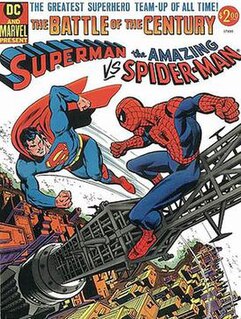 W
WSuperman vs. The Amazing Spider-Man: The Battle of the Century is a comic book jointly published by Marvel Comics and DC Comics in March 1976. It was the second co-publishing effort between DC Comics and Marvel Comics following their collaboration on MGM's Marvelous Wizard of Oz, and the first modern superhero intercompany crossover.
 W
WTales of the Zombie was an American black-and-white horror comics magazine published by Magazine Management, a corporate sibling of Marvel Comics. The series ran 10 issues and one annual publication from 1973 to 1975, many featuring stories of the zombie Simon Garth by writer Steve Gerber and artist Pablo Marcos.
 W
WThor Odinson is a fictional superhero appearing in American comic books published by Marvel Comics. The character, which is based on the Norse deity of the same name, is the Asgardian god of thunder who possesses the enchanted hammer, Mjolnir, which grants him the ability to fly and manipulate weather amongst his other superhuman attributes.
 W
WThe ThunderCats comic book series was based on the original television series of the same name. It was originally published by Marvel Comics through its Star Comics imprint in 1985, lasting for 3 years and 24 issues. During this time, a new series was published by Marvel UK consisting of 129 issues and was also published for three years. Beginning in 2002 Thundercats titles were published by Wildstorm Productions, and including 5 mini-series and several one-shots.
 W
WThe Tomb of Dracula is an American horror comic book series published by Marvel Comics from April 1972 to August 1979. The 70-issue series featured a group of vampire hunters who fought Count Dracula and other supernatural menaces. On rare occasions, Dracula would work with these vampire hunters against a common threat or battle other supernatural threats on his own, but more often than not, he was the antagonist rather than protagonist. In addition to his supernatural battles in this series, Marvel's Dracula often served as a supervillain to other characters in the Marvel Universe, battling the likes of Blade the Vampire Slayer, Spider-Man, the Werewolf, the X-Men, Howard the Duck, and the licensed Robert E. Howard character Solomon Kane.
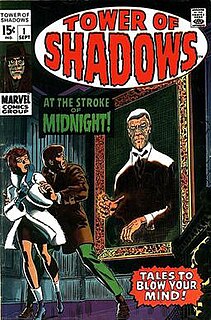 W
WTower of Shadows is a horror/fantasy anthology comic book published by the American company Marvel Comics under this and a subsequent name from 1969 to 1975. It featured work by writer-artists Neal Adams, Jim Steranko, Johnny Craig, and Wally Wood, writer-editor Stan Lee, and artists John Buscema, Gene Colan, Tom Sutton, Barry Windsor-Smith, and Bernie Wrightson.
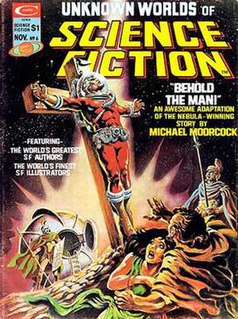 W
WUnknown Worlds of Science Fiction was a 1970s American black-and-white, science fiction comics magazine published by Marvel Comics' parent company, Magazine Management.
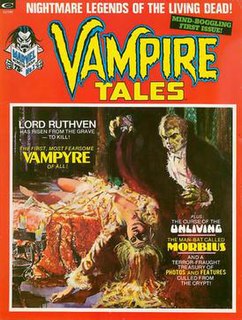 W
WVampire Tales was an American black-and-white horror comics magazine published by Magazine Management, a corporate sibling of Marvel Comics. The series ran 11 issues and one annual publication from 1973 to 1975, and featuring vampires as both protagonists and antagonists.
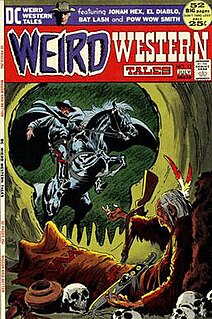 W
WWeird Western Tales is a Western genre comics anthology published by DC Comics from June–July 1972 to August 1980. It is best known for featuring the adventures of Jonah Hex until #38 when the character was promoted to his own eponymous series. Scalphunter then took Hex's place as the featured character in Weird Western Tales.
 W
WThe Witching Hour was an American comic book horror anthology published by DC Comics from 1969 to 1978.
 W
WWonder Woman is an ongoing American comic book series featuring the DC Comics superhero Wonder Woman and occasionally other superheroes as its protagonist. The character first appeared in All Star Comics #8, later featured in Sensation Comics series until having her own solo title.
 W
WWorld's Finest Comics was an American comic book series published by DC Comics from 1941 to 1986. The series was initially titled World's Best Comics for its first issue; issue #2 switched to the more familiar name. Michael E. Uslan has speculated that this was because DC received a cease and desist letter from Better Publications, Inc., who had been publishing a comic book entitled Best Comics since November 1939. Virtually every issue featured DC's two leading superheroes, Superman and Batman, with the earliest issues also featuring Batman's sidekick, Robin.
 W
WWorlds Unknown was a science-fiction comic book published by American company Marvel Comics in the 1970s, which adapted classic short stories of that genre, including works by Frederik Pohl, Harry Bates, and Theodore Sturgeon.
 W
WYoung Love was one of the earliest romance comics titles, published by Crestwood/Prize and later sold to DC Comics.